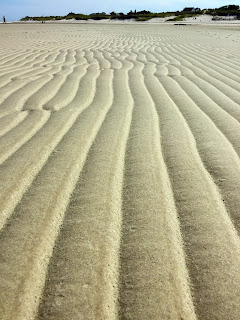NATURE NEWS
Ripple marks tell quite a story

I was at the beach this past Labor Day weekend enjoying the sun and wind before Hurricane Hermine hit. As the tide receded, it exposed a nicely rippled beach that was fun to walk on – it felt like a massage of sorts.
I had recently read parts of an old paper by a Mrs. Hertha Ayrton published in 1910
in the "Proceedings of the Royal Society of London" entitled “The Origin and Growth of Ripple-mark.” I love old scientific papers. They often reflect a delightful, old-school sense of wonder and curiosity. |
| Ripples formed by waves from different directions |
According to Mrs. Ayrton, “To anyone who, for the first time, sees a great stretch of sandy shore covered with innumerable ridges and furrows, as if combed with a giant comb, a dozen questions must immediately present themselves. How do these ripples form? Are they made and wiped out with every tide, or do they take a long time to grow, and last for many tides? What is the relation between the ripple and the waves to which they owe their existence? And a host of others too numerous to mention.” This is just what I was thinking about as I dug my toes into those mini-sand dunes on the beach.
The science of ripple formation is amazingly complicated. I can understand the simpler, superficial stuff, but I think one would have to go back to school to understand the deeper, underlying concepts (or I would, anyway).
Ripples in sand can be formed by wind or waves. The ripples I observed on the beach looked to be mostly formed by water, since they were being uncovered by the outgoing tide. These kinds of wave ripples form both on rising and falling tides and can be changed, modified or wiped out completely depending upon conditions.
The ripples on my particular beach were flat-topped ripples; spectacular in that they were so broad, flat-topped and evenly spaced. They ran perpendicular to the movement of the water, little sand dunes gently sloping on the shore side and falling off sharply on the side nearest the ocean.
According to Orrin H. Pilkey (“How to Read a North Carolina Beach”), this kind of ripple is created during a tidal cycle in which the ripples first formed when the current was flowing in, then on the falling tide the ripples were decapitated as the sediment was carried back out to sea.
The steep side of the ripple (or dune, or wave, for that matter) is usually the leeward side – the side away from the wave (or wind). In some places, more complex
 |
| Plover tracks on ripples |
Wind and water moving over loose sand can create tiny ripples that stretch just centimeters or form huge dunes that stretch for miles. These types of patterns are, collectively, known as bedforms.
Scientists aren’t just interested in terrestrial bedforms. Recent images taken by NASA’s Mars rover Curiosity show a new kind that is intermediate in size between Earth’s ripples and dunes. These Martian bedforms look like those formed by water but instead were formed by the winds of Mars.
Researchers think that because the Martian atmosphere is thinner (lower density) than Earth’s atmosphere, air moving over the sand has a greater effect on Mars than it would have on Earth, therefore acting more like water currents than air. I think Mrs. Ayrton would love to be alive today to add the origin of the ripples on Mars to her host of other questions about ripple formation that were “too numerous to mention.”



Comments
Post a Comment